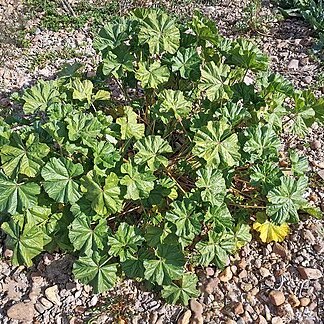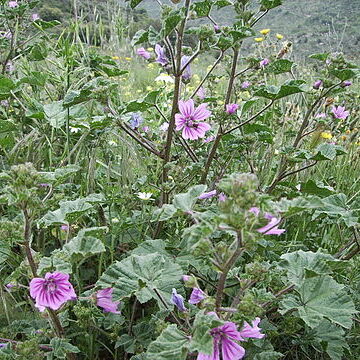Herbs, subshrubs, shrubs, or trees, usually stellate-hairy. Leaves alternate, usually spiral, sometimes distichous (Malvoideae), usually petiolate, sometimes subsessile or sessile (Malvoideae), stipulate (usually well developed), simple (compound in Abelmoschus); blade unlobed or palmately lobed, palmately veined. Inflorescences axillary, terminal, or leaf-opposed. Flowers bisexual or unisexual, usually actinomorphic; involucel (epicalyx) sometimes deciduous (Malvoideae, Sterculioideae), (4–)5(–8), distinct or connate; petals 4 or 5 (absent in Bombacoideae and Sterculioideae, rarely absent in Grewioideae); nectaries glandular hairs on adaxial base of sepals, petals, or androgynophores, sometimes absent; androgynophore present or absent; stamens [4–]5–100[–1500], usually in antipetalous groups; usually same number as sepals, distinct or connate, sessile or on androgynophore; ovules (1–)2–many per ovary. Fruits usually capsules, sometimes follicles, schizocarps, berries, or nuts. Seeds: cotyledons usually folded, endosperm absent or sparse to copious.
Trees, shrubs or herbs, rarely climbers; indumentum often of stellate hairs and with scattered mucilage-producing cells. Leaves alternate, simple or palmately lobed or compound, petiolate; stipules usually present. Inflorescence axillary, leaf-opposed or terminal, usually many-flowered cymes or panicles, or flowers solitary or paired; epicalyx of 3 or more bracts usually present. Flowers bisexual (rarely unisexual), usually actinomorphic. Sepals usually 5, free or united at base, valvate in bud. Petals 5, sometimes minute or absent, free. Stamens usually numerous (rarely as few as 5), filaments often united for most of their length into a tube, sometimes adnate to base of petals; staminodes often present; anthers dehiscing by longitudinal slits or terminal pores. Gynoecium of (1–) 5 (–many) free or fused carpels; styles free or united, simple or branched. Fruit a loculicidal capsule, sometimes separating into woody mericarps, rarely a berry or samara. Seeds sometimes winged, pubescent or arillate, endosperm abundant to absent.
Ovary superior, (1) 2-multilocular (carpels rarely in vertical rows); style simple at the base, often branched towards the apex, branches the same number as or twice as many as the carpels; ovules 1-numerous in each loculus; placentation axile
Fruit a loculicidally dehiscent capsule or composed of follicles, achenes or pseudo-achenes arranged around a central columella, or indehiscent and woody or fleshy
Herbs, shrublets, shrubs or small trees, usually with stellate hairs or bristles, sometimes aculeate, more rarely lepidote
Petals 5, free from each other but often adnate at the base to the staminal column, contorted or imbricate
Seeds usually with some endosperm and straight or curved embryo, the cotyledons often folded
Petals 5, free but often slightly adnate to the staminal tube, contorted or imbricate
Ovary syncarpous, rarely of 1 carpel, rarely the carpels in vertical rows; style one
Herbs often with fibrous stems or rarely shrubs; hairs usually stellate or lepidote
Stamens numerous, united in, a tube surrounding the style; anthers 1-thecous
Calyx (3–4) 5-lobed, truncate or occasionally 5-or 10-toothed; lobes valvate
Leaves alternate, often palmately nerved or divided; stipules present
Leaves alternate, usually petiolate, often palmately divided
Seeds usually with some endosperm; cotyledons often folded
Sepals valvate, with or without an epicalyx of bracteoles
Flowers actinomorphic, hermaphrodite or rarely unisexual
Fruit a capsule or breaking into separate compartments
Flowers bisexual (rarely unisexual), actinomorphic
Stamens numerous, monadelphous; anthers 1-celled
Epicalyx present or absent
Ovules on axile placentas
Stipules present


